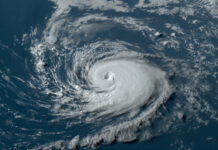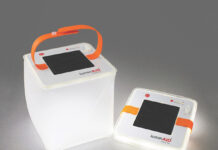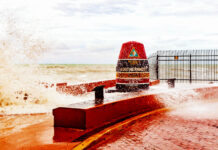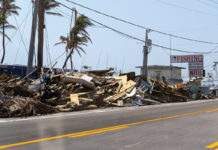By Kim Bassett
Hurricane Irma didn’t just bring wind and rain; it introduced conditions where black mold flourishes and grows rampantly.
What is black mold? Black mold is a type of toxic mold called Stachybotrys chartarum. As with all molds, black mold loves the damp, humid environment of the Keys, but with the added complication of receding flood or storm water damage, we once again have the “perfect storm.”
Black mold feeds on damp drywall, carpet, insulation and sub-flooring – pretty much any surface that is porous and allows moisture to become trapped. As with any mold, it contains spores that when disturbed or discovered in large quantity can affect your health because it emits a toxin called mycotoxin, not to mention the damage it does to your home or business.
How does black mold differ from regular mold? The biggest visible difference is the color. Black mold is black or very dark green, where typical mold is generally brown or lighter green. The “regular” mold is not considered toxic because it doesn’t contain mycotoxin; however, allergy sufferers will still experience symptoms with any mold. No mold is good mold when it comes to the air quality in your home or business. It needs to be properly treated before it becomes a health hazard.
What are symptoms from exposure to black mold? There is a wide range, depending on the sensitivity and exposure level of the person, including:
Shortness of breath
Sinus congestion or chronic cough
Fatigue and weakness
Red eyes
Blurred vision
Sweats
Light-headedness
Skin rash
Skin tingling
Joint pain, stiffness
Poor memory
Headache, light sensitivity
Increased thirst or urinary frequency
Metallic taste in mouth
What to do if you are experiencing symptoms:
Remove yourself immediately from the environment.
Do not wear clothing stored in the same environment, as it may be contaminated with mold spores too.
Make an appointment with your medical care provider. If you are having trouble breathing, call 911 or get to the emergency room as quickly as possible.
If symptoms are milder, take an antihistamine and/or a decongestant if nasal passages are swollen.
Follow up any over-the-counter treatment with a visit to your doctor. Depending on your exposure and level of sensitivity to the black mold, he/she may want to prescribe you a stronger medication to get your body’s reaction to the toxic mold under control.
Black mold is not your friend and the sooner you can get treatment both to you personally and to the structure it has infested, the better.
- Kim Bassett is a registered nurse and health care executive with more than 25 years’ experience. To see her full bio, visit kimbassettflorida.com.



























